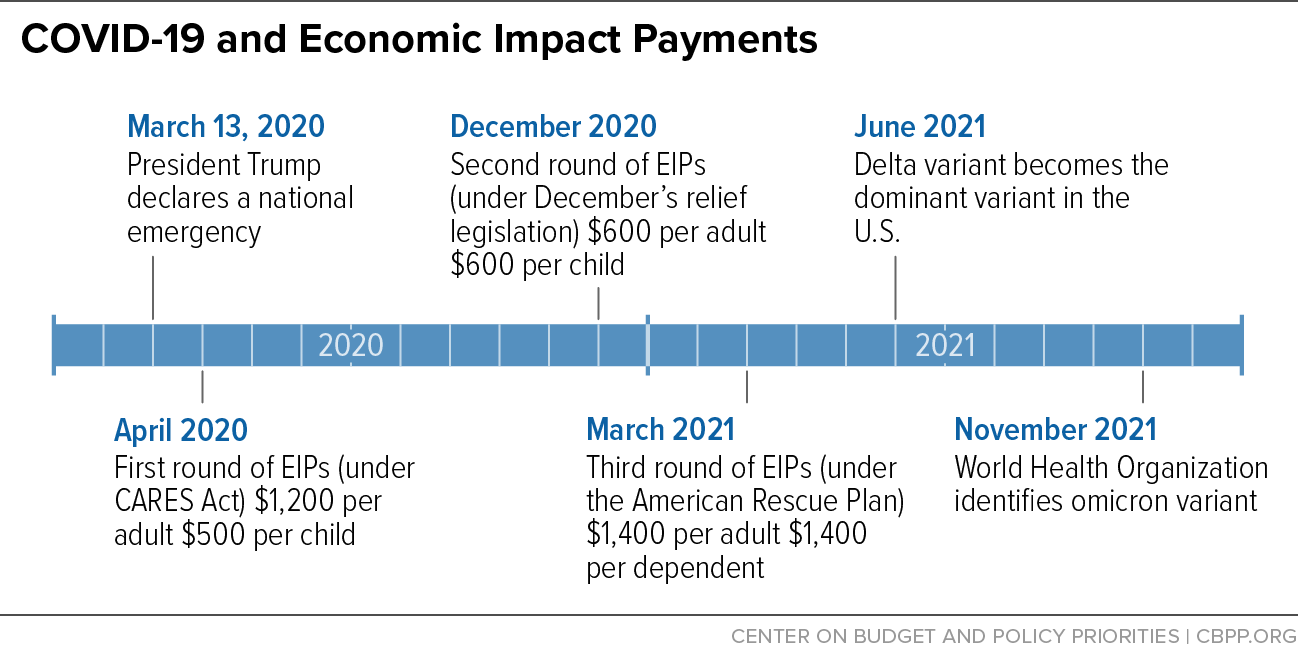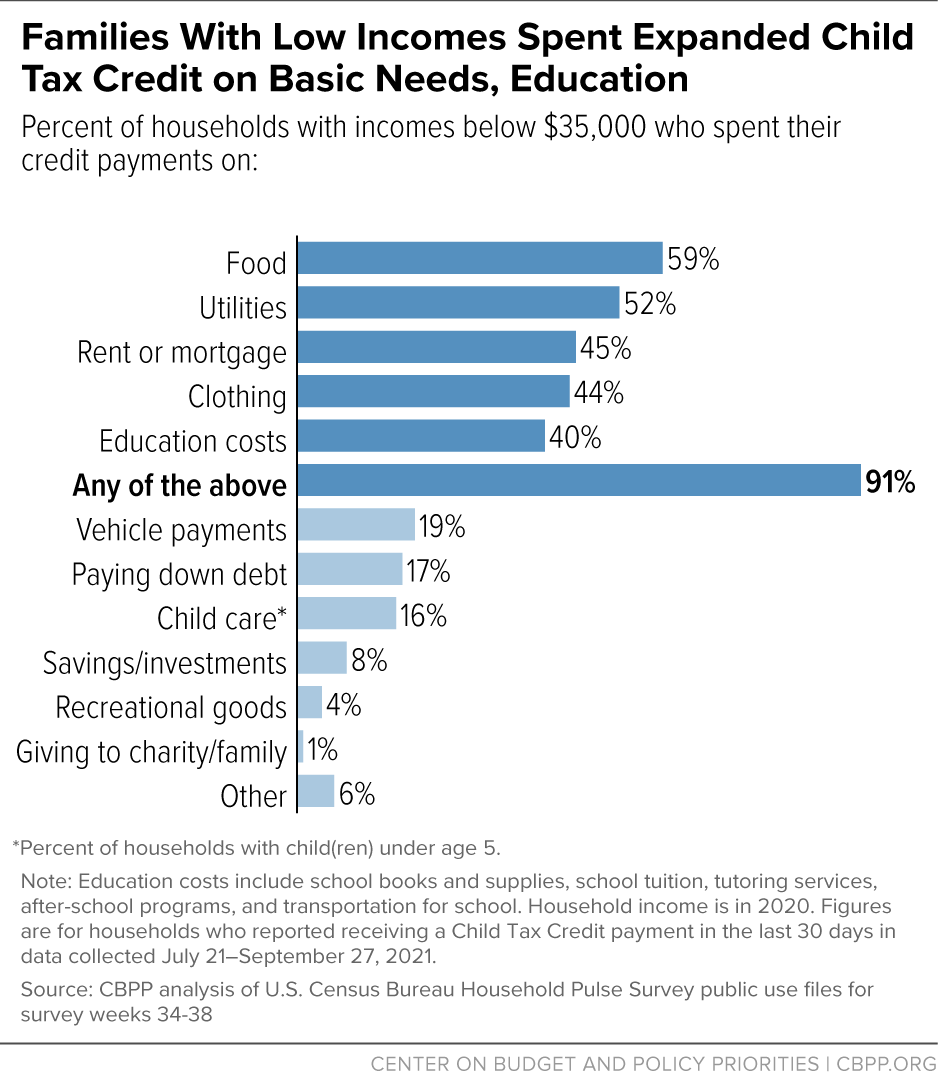When COVID-19 began to spread rapidly across the United States in March 2020, the economy quickly shed more than 20 million jobs. Amid intense fear and hardship, federal policymakers responded, enacting five bills in 2020 that provided an estimated $3.3 trillion of relief and the American Rescue Plan in 2021, which added another $1.8 trillion. This robust response helped make the COVID-19 recession the shortest on record and helped fuel an economic recovery that brought the unemployment rate, which peaked at 14.8 percent in April 2020, down to below 4 percent. One measure of annual poverty declined by the most on record in 2020, in data back to 1967, and available data suggest that poverty levels in 2021 were similar to 2020. Two critical components of the fiscal response were Economic Impact Payments (EIPs) and the expanded Child Tax Credit, which quickly delivered much-needed income to families struggling to pay their bills.
With both the EIP and the Child Tax Credit, policymakers built on prior policies but with innovative design improvements to expand eligibility and make access easier:[1]
-
EIPs. Relief legislation provided three rounds of Economic Impact Payments, delivered primarily via direct deposit, to most households. For the first time, and with strong bipartisan support, policymakers made households eligible for stimulus payments regardless of whether they filed taxes or had a minimum level of income. Furthermore, each round of relief legislation expanded eligibility to certain groups previously left out, including adults claimed as tax dependents and certain households that include immigrants. In addition, the IRS worked with the Social Security Administration and Department of Veterans Affairs to deliver the payments automatically to certain recipients of federal benefits, including older adults, people with disabilities, and veterans.
Moreover, while the pandemic made getting help to some people more difficult, the emergency also spurred new approaches to delivery — such as an online portal for people with low incomes who don’t ordinarily file tax returns — that will have lasting value for providing improved access to IRS-delivered benefits.
- Child Tax Credit. For 2021 only, the Rescue Plan raised the maximum Child Tax Credit from $2,000 to $3,600 for children under 6 and $3,000 for children aged 6-17 (the first time 17-year-olds were included). Most importantly, for the first time it made the Child Tax Credit “fully refundable,” meaning the full credit was available to all children in families with low or no earnings in a year. Prior to the Rescue Plan, an estimated 27 million children received less than the full Child Tax Credit amount because their families’ incomes were too low, including roughly half of Black children, half of Latino children, roughly 20 percent of white children, 20 percent of Asian children, and roughly half of children living in rural areas. Also for the first time, half of the expanded Child Tax Credit amount was delivered on a monthly basis from July to December 2021.
These changes led to a significant reduction in child poverty, keeping an estimated 3.7 million children out of poverty (measured by monthly income) in December 2021.[2] Economic assistance in childhood has been found to improve low-income children’s health and educational outcomes and lead to higher earnings in adulthood. Policymakers can promote these near- and long-term benefits for children by expanding the Child Tax Credit again, most importantly by making it fully refundable on a permanent basis.
To provide income support and shore up overall consumer demand, relief legislation enacted in 2020 and 2021 — the CARES Act of March 2020, relief legislation enacted in December 2020, and the American Rescue Plan of March 2021 — provided a total of three rounds of EIPs to most households, ranging from $600 to $1,400 per adult and $500 to $1,400 per child (or other dependent, in the third round). (See Figure 1.) In total, the IRS issued over 480 million EIPs, with each round reaching 146 to 175 million households.[3] The IRS also issued initial payments automatically within weeks of the bills’ enactment, much faster than similar payments made in 2008 in response to the Great Recession. This enabled recipients to receive and use the payments quickly, which was especially important given that the first round of EIPs was issued early in the pandemic amid peak job losses.
The first two rounds alone lifted 11.7 million people above the poverty line in 2020, including 3.2 million children, according to the Census Bureau’s Supplemental Poverty Measure (and measuring income and poverty on an annual basis). The third round similarly lifted more than 11 million people above the poverty line in 2021, according to a preliminary estimate by the Urban Institute.[4] People of all racial and ethnic groups benefited from this strong anti-poverty effect, according to the Census Bureau. The first two rounds of EIPs reduced the poverty rates for Black and Latino children by 6.8 percentage points each, for Asian children by 3.6 percentage points, and for white children by 2.8 percentage points, lifting 756,000 Black children, 1.3 million Latino children, 153,000 Asian children, and 1 million white children out of poverty.[5]
The EIPs’ success in reaching those who needed help partly reflected design and implementation improvements compared to the 2008 stimulus payments on which they were modeled. These improvements included:
No earnings threshold. Households did not need a minimum level of income or earnings to qualify for EIPs. The 2008 payments, in contrast, went only to households who had filed tax returns and had a minimum level of income, and only those with sufficient incomes received the full amount. The EIPs were therefore the first time the IRS provided direct cash payments to households with no minimum earnings threshold or tax filing requirement, so people with the lowest incomes were eligible for the full rebate amount.
Automatic delivery. About 3.5 million recipients of Social Security or certain veterans’ benefits, who were generally not required to file federal income tax returns, lost out on the 2008 stimulus payment because they either didn’t know they had to file a tax return to claim the payment or couldn’t overcome the hurdles in that process.[6] This time, lawmakers gave the Treasury Department the authority to coordinate with other federal agencies and deliver EIPs automatically to recipients of Social Security, Supplemental Security Income, railroad retirement, and certain veterans’ benefits, rather than forcing them to file tax returns to provide information that other federal agencies already had available. This also enabled the Treasury Department to issue EIPs to these recipients more quickly than if they had to wait for them to file tax returns, expediting payments to people during the recession when time was of the essence.
Non-Filer portal. For individuals who did not file a return but were not eligible for automatic payment of EIPs, the IRS set up a portal, or “Non-Filer” tool, which provided an imperfect but simplified online form. Around 8 million people claimed EIPs using the Non-Filer tool, the IRS estimates.[7]
Inclusion of households who include immigrants and of adult dependents. The first round of EIPs excluded an estimated 15 million otherwise-eligible people — including around 4 million children who are U.S. citizens — if any adult listed on the household’s tax return lacked a Social Security number (SSN).[8] This harsh, misguided rule excluded many families that include immigrants who were working on the front lines in the pandemic, such as by providing health care, delivering food, or caring for vulnerable older people. It also excluded other immigrants employed in economic sectors that were hit with mass layoffs.
Lawmakers partly corrected this policy failure in subsequent legislation. The second round of EIPs included all adults with SSNs and their children with SSNs (and retroactively granted eligibility to this group for the first EIPs), and the third round further expanded EIP eligibility to include any child who has an SSN, even if neither parent does. The third round also expanded eligibility to all dependents left out of the first two rounds on the basis of age (except those who lacked SSNs), which had included about 5 million 17- and 18-year-olds, nearly 4 million college students aged 19 to 23, about 400,000 children aged 19 and older with disabilities, and more than 5 million other adult relatives (such as older parents) who have little income and are claimed as tax dependents by their children or other relatives.[9] Yet individuals who file taxes with Individual Tax Identification Numbers (ITINs) were still excluded from all rounds of payments, and children with SSNs whose parents file taxes using ITINs were excluded from the first and second rounds.
Policymakers should heed the lessons learned from the three rounds of EIPs to help prepare for — and respond to — future crises. For example, they should build on Treasury’s automatic delivery capability so that when the next crisis hits, the federal government is well positioned to efficiently deliver automatic cash payments to as many eligible individuals as possible. They also should authorize, and fund, the IRS to analyze the performance of the Non-Filer tool and make necessary technological upgrades so it can be quickly repurposed in another crisis. And future stimulus payments should, from the start, include all population groups reached by the third round of EIPs as well as individuals who file taxes with ITINs.
There will be opportunities for other improvements in EIP design and delivery in a future crisis. For instance, the policy is “dialable,” both in the overall level of payments it provides (which should reflect economic conditions) and the degree to which it includes households who had higher incomes before the crisis hit.
Further, policymakers should explore ways to reach eligible households who may have missed out on EIPs because they don’t typically file tax returns and face barriers to filling out the Non-Filer tool, such as limited internet access, non-native English speakers in the family, or lack of a bank account or stable address. Governors and state officials can play a central role in outreach efforts by notifying families enrolled in SNAP or Medicaid that they are eligible for payments and by providing resources to help fill out the required forms. State agencies can partner with community-based organizations to reach people not connected to SNAP or Medicaid, such as families experiencing housing instability. And policymakers could authorize states to make payments on behalf of the federal government to people whom the state knows to be eligible but who have not filed a tax return or applied through the portal; this idea should be explored now so policymakers can understand what might be necessary to make such a system workable.
The American Rescue Plan’s one-year Child Tax Credit expansion increased the maximum credit amount,[10] made the credit fully refundable, allowed families to claim their 17-year-old children for the first time, and delivered half of the credit via advance monthly payments rather than entirely as a lump sum at tax time. Monthly payments of the expanded credit reached the vast majority of eligible children, with the Treasury Department issuing payments to over 61 million children in more than 37 million families during the second half of 2021.[11] Also, the IRS established an online portal that people who had not filed a return in either of the prior two years could use to sign up for monthly payments of the credit. About 2 million more children were issued payments in December than in July (the first month of payments), a notable increase that suggests participation could rise further if an expanded credit were made permanent.
The monthly payments sharply reduced child poverty. In December 2021, by which time most families had received half of their annual credit through advance monthly payments, they kept an estimated 3.7 million children out of poverty (using a monthly poverty measure), a 29 percent reduction that was reversed the following month after the monthly payments expired.[12]
The vast majority of families with low incomes spent their payments on necessities — food, housing, clothing, utilities — and education, data from the Census Bureau’s Household Pulse Survey show.[13] (See Figure 2.) The share of adults with children reporting that their family didn’t have enough food to eat in the past seven days dropped significantly after the first round of monthly payments, according to Pulse data.[14] Among parents with income under $25,000, the share responding that they were financially “doing okay” or better rose by 13 percentage points, from 40 percent in 2020 to 53 percent in 2021 (relative to an 8 percentage point rise among parents overall). Similarly, the share of parents across income levels who would be able to pay for a $400 unexpected expense with cash rose from 56 percent in 2020 to 64 percent in 2021. Potential explanations for these increases in financial security include the expanded Child Tax Credit.[15]
Making the credit fully refundable also reduced racial and geographic income disparities. As noted, prior to the Rescue Plan an estimated 27 million children received less than the full credit or no credit at all because their families’ incomes were too low.[16] This group included roughly half of Black children and half of Latino children — significantly more than the still-substantial share among white children and Asian children (about one-fifth of each group).[17] It also included roughly half of children living in rural areas.[18] Full refundability made all of these children eligible for the full credit amount — the same amount that families with higher incomes (but below the income level at which the credit began to phase down) receive.
While some analysts predicted the payments would discourage many people from working, there is no evidence that the payments meaningfully reduced parental employment during 2021.[19]
Researchers reviewing the evidence from the first six months of payments concluded: “In its first six months, the expanded Child Tax Credit has shored up family finances amidst the continuing crisis, reduced child poverty and food insufficiency, increased families’ abilities to meet their basic needs, and has had no discernable negative effects on parental employment.”[20]
Beyond reducing immediate hardship, the Child Tax Credit expansions constitute a high-return investment in children’s futures. Poverty and its attendant hardships shortchange children for decades, research shows.[21] Early results from a recent major study also show that cash assistance to mothers may aid children’s brain development from infancy.[22] These near-term results bolster previous studies linking additional income to better outcomes for children in families with low incomes, including better educational performance and attainment, higher earnings in adulthood, and better health, which can yield benefits for children and their communities over the course of their lives.[23]
The Rescue Plan’s temporary Child Tax Credit expansion demonstrated that we can achieve substantial, permanent reductions in child poverty. Expanding the Child Tax Credit, including permanent refundability and monthly payments, could change lifelong outcomes for millions of children living below the poverty line.
The Rescue Plan’s improvements in the Child Tax Credit also reached all five U.S. territories — Puerto Rico, Guam, U.S. Virgin Islands, American Samoa, and the Northern Mariana Islands — which together are home to nearly 4 million U.S. residents. Not only did the Rescue Plan extend its temporary expansions of the credit to the territories; it also permanently erased long-standing discriminatory barriers that had prevented the bulk of families with children in the territories from accessing the credit. Together, these changes will significantly reduce child poverty in the territories, which is much higher than in the rest of the country.a The child poverty rate in Puerto Rico, for example, is 57 percent.
For Puerto Rico, the most populous of the territories, the Rescue Plan expanded eligibility for the Child Tax Credit by permanently making families with one or two children eligible, thereby correcting a long-standing flaw that had limited the credit to just families with three or more children. Together, the Rescue Plan’s one-year expansion of the Child Tax Credit nationally and its permanent eligibility expansion for Puerto Rico made an estimated 97 percent of all families with children in the territory (or 304,000 families) eligible for the credit in 2021, of which 89 percent or roughly 271,000 are families with one or two children that became newly eligible, according to the Instituto del Desarrollo de la Juventud (IDJ).b Moreover, these changes are expected to boost the median income of Puerto Rico families living under the poverty threshold by 53 percent, the IDJ study finds. (Residents of Puerto Rico didn’t receive advance payments of the credit but instead received the full amount when they filed their 2021 taxes during the 2022 filing season.)
For the other four territories, the Rescue Plan provided clarity on the Child Tax Credit amounts their residents can receive, as well as the federal funding needed to cover the cost of these benefits permanently.c (The extent to which families in these territories received the credit before the Rescue Plan is unclear.) Under the Rescue Plan, benefit amounts are on par with those in the states.
In addition to expanding the Child Tax Credit in upcoming economic legislation, policymakers should provide all the territories with support to spread awareness about the expansions, given the steep economic challenges, language barriers, and other obstacles to enrollment they face. This is particularly important in Puerto Rico to ensure that as many eligible families as possible claim the credit given the previous eligibility limitation.
a Javier Balmaceda, “Tax Credit Expansions Expected to Significantly Reduce Poverty in Puerto Rico,” CBPP, March 14, 2022, https://www.cbpp.org/blog/tax-credit-expansions-expected-to-significantly-reduce-poverty-in-puerto-rico.
b Instituto del Desarrollo de la Juventud, “Child Tax Credit: Transformative Impact on Families with Minors in Puerto Rico and Significant Contribution to the Local Economy,” January 11, 2022, https://mcusercontent.com/35b40b9cf147af1ed5717180c/files/812ac348-c1a4-ce60-c924-7856ccbe747e/Child_Tax_Credit_impacto_trascendental_a_las_familias_conmenores_IDJ_enero_2022_.pdf.
c Congressional Research Office, “The Expanded Child Tax Credit for 2021: Frequently Asked Questions (FAQs),” updated January 28, 2022, https://sgp.fas.org/crs/misc/R46900.pdf.




